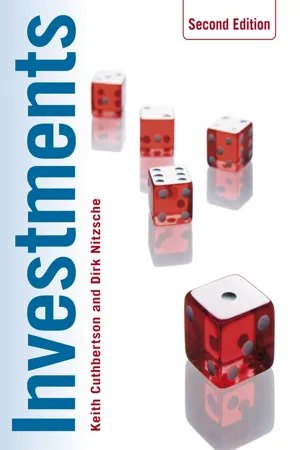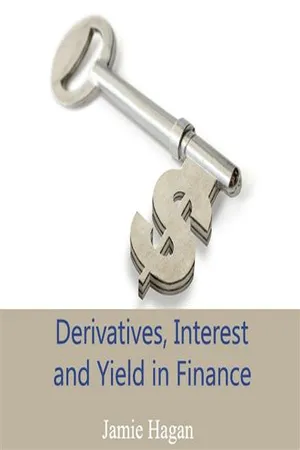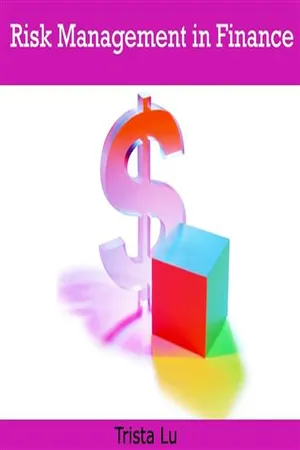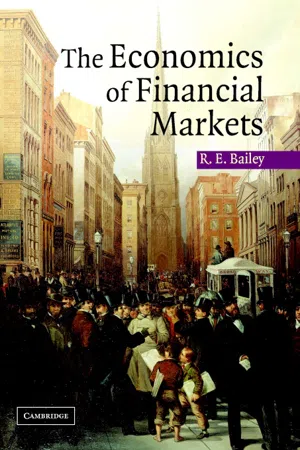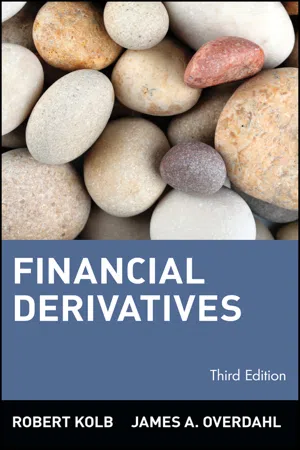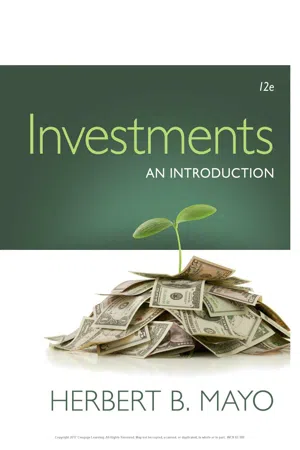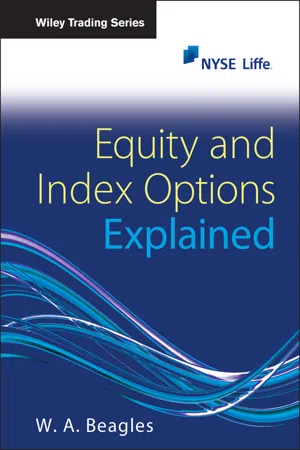Economics
Futures and Options
Futures and options are financial derivatives that allow investors to hedge against price fluctuations or speculate on the future price movements of assets such as commodities, stocks, or currencies. Futures contracts obligate the buyer to purchase an asset at a predetermined price and date, while options provide the buyer with the right, but not the obligation, to buy or sell an asset at a specified price within a set timeframe.
Written by Perlego with AI-assistance
Related key terms
1 of 5
10 Key excerpts on "Futures and Options"
- eBook - PDF
- Brian Kettell(Author)
- 2001(Publication Date)
- Butterworth-Heinemann(Publisher)
Forward contracts are negotiated between the contracting parties and are not traded on organized exchanges. Futures Contract: A contract to buy or sell a specified amount of a designated commodity, currency, security, or financial instrument at a known date in the future and at a price set at the time the contract is made. Futures contracts are traded on organized exchanges and are thus standardized. The contracts are marked to market daily, with profits and losses settled in cash at the end of the trading day. Option Contract: A contract that gives its owner the right, but not the obligation, to buy or sell a specified asset at a stipulated price, called the strike or exercise price. Contracts that give owners the right to buy are referred to as call options and contracts that give the owner the right to sell are called put options. Options include both standardized products that trade on organized exchanges and customized contracts between private parties. Swap Contract: A private contract between two parties to exchange cash flows in the future according to some prearranged formula. The most common type of swap is the ‘plain vanilla’ interest rate swap, in which the first party agrees to pay the second party cash flows equal to interest at a predetermined fixed rate on a notional principal. The second party agrees to pay the first party cash flows equal to interest at a floating rate on the same notional principal. Both payment streams are denominated in the same currency. Another common type of swap is the currency swap. This contract calls for the counterparties to exchange specific amounts of two different currencies at the outset, which are repaid over time according to a prearranged formula that reflects amortization and interest payments. 244 Economics for Financial Markets buyer has no commitment to buy gold at US$400, and the option buyer can then allow the option to expire unexercised, and purchase gold at the cheaper market price. - eBook - PDF
- Keith Cuthbertson, Dirk Nitzsche(Authors)
- 2014(Publication Date)
- Wiley(Publisher)
SUMMARY • In a forward contract a price is agreed today, for delivery of the underlying asset in the contract at a specific date in the future. Forward contracts are usually held to maturity, when delivery takes place. • Forward contracts are over-the-counter (OTC) agreements whose terms (e.g. size, delivery date and price) are negotiated between two counterparties. • Futures contracts if held to maturity are very similar to forward contracts. However, futures contracts are standardised agreements (e.g. size, delivery date) that are trad- ed on exchanges and their price fluctuates continuously. • Futures contracts involve a ‘good faith deposit’ that is known as a margin payment and most futures contracts are closed out before maturity. • Both forwards and futures can be used for hedging. Even if a futures contract is closed out before maturity, you can effectively ‘lock in’ the futures price quoted at time when the contract is entered into. • Options contracts can provide insurance in that they can be used to limit ‘downside risk’ while allowing ‘upside capture’. If you plan to purchase shares in the future and are worried that their price might rise, you can guarantee the maximum price you will have to pay by purchasing a call option today. If you already own shares and you are worried that their price might fall in the future, you can buy a put option that will fix the minimum price you will receive for your shares. • Options can be used for speculation without having to put up much capital, since you only pay a small option premium (relative to the spot price of the underlying asset) – so options provide leverage. • Acting as a speculator, if you think that stock prices will rise (fall) in the future you would buy a call (put) option. The most a speculator can lose when buying calls or puts are the respective option premia. But a speculator who sells (writes) a call or put option has almost unlimited risk. - No longer available |Learn more
- (Author)
- 2014(Publication Date)
- Research World(Publisher)
____________________ WORLD TECHNOLOGIES ____________________ Chapter-3 Futures Contract In finance, a futures contract is a standardized contract between two parties to buy or sell a specified asset (e.g. oranges, oil, gold) of standardized quantity and quality at a specified future date at a price agreed today (the futures price or the strike price). The contracts are traded on a futures exchange. Futures contracts are not direct securities like stocks, bonds, rights or warrants. They are still securities, however, though they are a type of derivative contract. The party agreeing to buy the underlying asset in the future assumes a long position, and the party agreeing to sell the asset in the future assumes a short position. The price is determined by the instantaneous equilibrium between the forces of supply and demand among competing buy and sell orders on the exchange at the time of the purchase or sale of the contract. In many cases, the underlying asset to a futures contract may not be traditional commodities at all – that is, for financial futures , the underlying asset or item can be currencies, securities or financial instruments and intangible assets or referenced items such as stock indexes and interest rates. The future date is called the delivery date or final settlement date . The official price of the futures contract at the end of a day's trading session on the exchange is called the settlement price for that day of business on the exchange. A closely related contract is a forward contract; they differ in certain respects. Futures contracts are very similar to forward contracts, except they are exchange-traded and defined on standardized assets. Unlike forwards, futures typically have interim partial settlements or true-ups in margin requirements. For typical forwards, the net gain or loss accrued over the life of the contract is realized on the delivery date. - No longer available |Learn more
- (Author)
- 2014(Publication Date)
- White Word Publications(Publisher)
____________________ WORLD TECHNOLOGIES ____________________ Chapter-12 Futures Contract In finance, a futures contract is a standardized contract between two parties to buy or sell a specified asset (e.g. oranges, oil, gold) of standardized quantity and quality at a specified future date at a price agreed today (the futures price or the strike price). The contracts are traded on a futures exchange. Futures contracts are not direct securities like stocks, bonds, rights or warrants. They are still securities, however, though they are a type of derivative contract. The party agreeing to buy the underlying asset in the future assumes a long position, and the party agreeing to sell the asset in the future assumes a short position. The price is determined by the instantaneous equilibrium between the forces of supply and demand among competing buy and sell orders on the exchange at the time of the purchase or sale of the contract. In many cases, the underlying asset to a futures contract may not be traditional commodities at all – that is, for financial futures , the underlying asset or item can be currencies, securities or financial instruments and intangible assets or referenced items such as stock indexes and interest rates. The future date is called the delivery date or final settlement date . The official price of the futures contract at the end of a day's trading session on the exchange is called the settlement price for that day of business on the exchange. A closely related contract is a forward contract; they differ in certain respects. Futures contracts are very similar to forward contracts, except they are exchange-traded and defined on standardized assets. Unlike forwards, futures typically have interim partial settlements or true-ups in margin requirements. For typical forwards, the net gain or loss accrued over the life of the contract is realized on the delivery date. - eBook - PDF
- Roy E. Bailey(Author)
- 2005(Publication Date)
- Cambridge University Press(Publisher)
20 Options markets III: applications Overview Options contracts are used in a multitude of different ways for different purposes. For example, an investor who plans to acquire shares in a company but considers that the current price is too high might choose to write put options on the shares. If the share price remains high during the life of the options, the options are not likely to be exercised and the investor pockets the option premium, without buying the shares. Alternatively, if the share price falls and the options are exercised against the investor, the shares are acquired, as the investor intended, at the exercise price. (In addition, the investor keeps the premium, of course.) Rather than attempt to catalogue all these policies, this chapter studies several applications that illustrate different aspects of options analysis. Section 20.1 begins with a review of stock index options. Sections 20.2 and 20.3 introduce options on futures contracts, together with a variety of applications. In particular, section 20.3 explains how options on interest rate futures can be used to construct caps and floors on the effective interest rate for borrowing or lending. Section 20.4 outlines how the inclusion of options in portfolios can mitigate the impact of uncertainty about future asset prices. Hedging, introduced in chapter 15, is re-examined using options (rather than futures) as hedge instruments. A successful hedge reduces the risks associated with asset price fluctuations. It is not designed to reap the benefits of asset price increases while also protecting the investor against losses when asset prices fall. Such protection is the goal of portfolio insurance, a class of policies designed to place a floor under the value of a portfolio, while not restricting its growth in the event of increases in the prices of assets held in the portfolio. - eBook - PDF
- Rob Quail, James A. Overdahl(Authors)
- 2003(Publication Date)
- Wiley(Publisher)
Wilford, Managing Financial Risk: A Guide to Derivative Products, Financial Engineering, and Value Maximization, Burr Ridge, IL and New York: Irwin Professional Pub- lishing, 1995. 96 CHAPTER 4 Options B ecause options markets are diverse and have their own particular jargon, understanding them requires a grasp of institutional details and market terminology. This chapter begins with a discussion of the institutional back- ground of options markets, including the kinds of contracts traded and the price quotations for various options. The successful option trader must also understand the pricing rela- tionships that prevail in the options market. For example, how much should an option to buy IBM at $100 be worth if IBM is selling at $120? With IBM trading at $120, how much more would an option be worth if it required a payment of only $90 instead of $100? Similarly, how much would an option to sell IBM for $115 be worth if IBM were trading at $120? Prospective option investors need answers to these kinds of ques- tions. Fortunately, the pricing principles for options are well developed. Although the answers to such questions may sometimes be surprising, they are logical on reflection. As options markets have proliferated, the ways to contract for the same good have grown. For example, there are futures contracts on for- eign currencies, such as the euro. There are also options on euros, and even an option on the euro futures contract. The chapter concludes by ex- ploring options on stock indexes, options on futures, and options on for- eign currencies. CALL AND PUT OPTIONS As discussed in Chapter 1, there are two major classes of options, call options and put options. Ownership of a call option gives the owner the right to buy a particular good at a certain price, with that right lasting until a particular date. Ownership of a put option gives the owner the right to sell a particular good at a specified price, with that right lasting - eBook - PDF
- Donald Spence(Author)
- 1997(Publication Date)
- Woodhead Publishing(Publisher)
N o w k n o w n as 'traded options', t h e y are 'derivatives' of futures a n d are t h e origin of t h e n a m e derivatives w h i c h h a s n o w devolved i n t o a m u l t i t u d e of financial activities, s o m e beneficial a n d some highly speculative. A n option is the right or choice - b u t n o t the obligation - for the pay-m e n t of a p r e m i u m , to b u y or sell a futures contract at s o m e agreed time in t h e future w h i c h can, in theory, b e years ahead. M o s t deals, however, are for a far shorter period of time. T h e r e are t w o principal types of options -calls a n d puts. If the investor t h i n k s t h e m a r k e t is going u p , h e b u y s a call option and, if d o w n , a p u t option. T h e taker of the o p t i o n pays a p r e m i u m to the grantor a n d s t a n d s to lose only t h a t a m o u n t , w h a t e v e r t h e m a r k e t does. H i s profits, o n the o t h e r h a n d , c a n b e unlimited. T h e g r a n t o r keeps the p r e m i u m a n d if the taker a b a n d o n s the option (i.e. the m a r k e t fails to m o v e in the right direction b y m o r e t h a n the p r e m i u m ) it b e c o m e s a straight profit. However, if t h e m a r k e t does m o v e in the right direction b y m o r e t h a n the p r e m i u m , the taker will exercise the option, m e a n i n g t h a t the g r a n t o r h a s to h o n o u r t h e o t h e r side. It is p r u d e n t , therefore, if granting calls, to have the currency, stock or c o m m o d i t y r e a d y for delivery. Other-wise, it m a y b e necessary to cover in a sharply m o v i n g m a r k e t , leading to substantial losses. For example - A n investor w i s h e s to b u y silver as h e t h i n k s the price will go u p . T h e price of silver t h r e e m o n t h s a h e a d is $5 p e r ounce, so h e p u r c h a s e s a call option to b u y 100 0 0 0 o u n c e s in n i n e t y days' time at $5.05 per ounce. - eBook - PDF
- Jeff Madura(Author)
- 2020(Publication Date)
- Cengage Learning EMEA(Publisher)
34 4 Part 5: Derivative Security Markets the option expire on the expiration date without exercising it. Call options grant a right, but not an obligation, to purchase a specified financial instrument. In contrast, buyers of futures contracts are obligated to purchase the financial instrument at a specified date. If the owner of a call option does exercise it, the seller (sometimes called the writer) of the option is obligated to provide the specified financial instrument at the price specified by the option contract. Sellers of call options receive an upfront fee (the premium) from the purchaser as compensation. 14-1b Markets Used to Trade Options The Chicago Board Options Exchange (CBOE), which was created in 1973, is the most important exchange for trading options. It serves as a market for options on more than 2,000 different stocks. The options listed on the CBOE have a standardized format, as will be explained shortly. The standardization of the contracts on the CBOE has proved to be a major advantage because it allows for easy trading of existing contracts (a sec- ondary market). With standardization, the popularity of options has increased, and the options have become more liquid. Because numerous buyers and sellers of the standard- ized contracts are available, buyers and sellers of a particular option contract can be readily matched. Options are also traded on the International Securities Exchange, which is owned by the Nasdaq, and on the New York Stock Exchange. In addition, options are traded at the CME Group, which also serves international markets for derivative products (as discussed in Chapter 13). Any particular option contract may be traded on various exchanges, and competition among those exchanges may result in more favorable prices for customers. At all the exchanges, most option trading is conducted electronically. - No longer available |Learn more
Investments
An Introduction
- Herbert Mayo(Author)
- 2016(Publication Date)
- Cengage Learning EMEA(Publisher)
The markets for these contracts, like the market for commodity futures, have two participants: the speculators and the hedgers. It is the inter action of these two parties (i.e., the demand and supply of each contract) that de -termines the futures price. The next sections present an introduction to financial futures and currency fu -tures. Initially stock index futures are covered, which includes a discussion of stock index arbitrage and programmed trading. Stock index arbitrage is important because it links the futures markets and the equity markets. If the futures price for stocks rises, arbitrage assures that the prices of stocks also rise. The process also works in reverse. If the futures price for equities declines, arbitrage assures that the decline is transferred to the stock market. A description of futures for debt instruments follows index arbi -trage. The last section on futures covers currency futures. Stock Market Futures Stock index futures are futures contracts based on an index of the stock market (e.g., the Standard & Poor’s 500 stock index or the New York Stock Exchange Compos -ite Index). These contracts offer speculators and hedgers opportunities for profit or risk reduction that are not possible through the purchase of individual securities. For example, the S&P 500 stock index futures contracts have a value that is 250 times the value of the index. Thus, if the S&P 500 stock index is 1,000, the contract is worth $250,000. By purchasing this contract (i.e., by establishing a long position), the holder profits if the market rises. If the index were to rise to 1,100, the value of the contract would increase to $275,000. The investor would then earn a profit of $25,000. Of course, if the S&Puni00A0500 Index should decline, the buyer would experience a loss. (“Mini” contracts that are worth 50 times the S&P 500 stock index are also available.) The sellers of these contracts also participate in the fluctuations of the market. - eBook - PDF
- W. A. Beagles(Author)
- 2009(Publication Date)
- Wiley(Publisher)
Option Uses 25 to buy options. Note that protection cannot be achieved by selling options. Selling options may bring in some cash, it may enhance yield, but it also increases risk. In everyday life, we buy insurance to protect ourselves, selling insurance to others would bring in some cash but also expose us to significant risk. By buying options to hedge an existing underlying position, protection is achieved and profit potential retained, but at a cost . Our willingness to pay that cost will depend upon our attitude to risk and our view of the market. These themes will be expanded upon in a later chapter on option spreads; specifi-cally, the sections on the “Fence” or “Collar”. Having considered how options may be used for hedging purposes, let’s now consider the other main use of options – speculation . USING OPTIONS TO SPECULATE Speculation may be defined as taking a risk in the hope or expectation of making a profit. In everyday terms, speculation is akin to gambling. Speculators risk some money in the hope of making some money. The idea is to limit risk while maximising potential profit. This “risk/reward” relationship is fundamental to all forms of trading. Derivatives in general are ideally suited to speculation for a number of reasons. Trading derivatives is more capitally efficient than physical trading due to the use of margin and marking-to-market. In turn, this capital efficiency allows for gearing or leverage, for greater exposure to the market. An example of this follows. Trading derivatives may also have tax advantages over physical trading. For ex-ample, stamp duty of 0.5% is payable when buying UK equities but is not payable when buying UK equity derivatives. Derivatives may allow us access to markets that would otherwise be inaccessible. A good example is the FTSE 100 Index. It would be highly impractical and expensive to trade the cash FTSE 100 Index.
Index pages curate the most relevant extracts from our library of academic textbooks. They’ve been created using an in-house natural language model (NLM), each adding context and meaning to key research topics.

